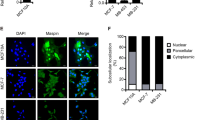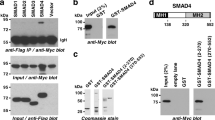Abstract
Maspin is a novel serine protease inhibitor (serpin) with tumor suppressive activity. To date, despite the mounting evidence implicating the potential diagnostic/prognostic and therapeutic value of maspin in breast and prostate carcinoma, the lack of a suitable animal model hampers the in vivo investigation on the role of maspin at different stages of tumor progression. In this study, we used MMTV/TGF-α transgenic mouse model to study the expression profile of maspin in mammary tumor progression. Histopathological examinations of MMTV/TGF-α transgenic mice revealed TGF-α expression leading to hyperproliferation, hyperplasia, and occasional carcinoma in mammary gland. Interestingly, when MMTV/TGF-α transgenic mice were breed to homozygocity, they also developed characteristic skin papillomas. Immunohistochemistry analysis of maspin expression in the breast tissues of TGF-α transgenic mice showed a direct correlation between down-regulation of maspin expression and tumor progression. The loss of maspin expression was concomitant with the critical transition from carcinoma in situ to invasive carcinoma. Subsequent in-situ hybridization analyses suggest that the down-regulation of maspin expression is primarily a transcriptional event. This data is consistent with the tumor suppressive role of maspin. Furthermore, our data suggests that MMTV/TGF-α transgenic mouse model is advantageous for in vivo evaluation of both the expression and the biological function of maspin during the slow multi-stage carcinogenesis of mammary gland.
This is a preview of subscription content, access via your institution
Access options
Subscribe to this journal
Receive 50 print issues and online access
$259.00 per year
only $5.18 per issue
Buy this article
- Purchase on Springer Link
- Instant access to full article PDF
Prices may be subject to local taxes which are calculated during checkout




Similar content being viewed by others
References
Carpenter G, Cohen S . 1979 Annu. Rev. Biochem. 48: 193–216
Derynck R . 1988 Cell 54: 593–595
Gottlieb AB, Chang CK, Posnett DN, Fanelli B, Tam JP . 1988 J. Exp. Med. 167: 670–675
Humphreys RC, Hennighausen L . 2000 Oncogene 19: 1085–1091
Jhappan C, Stahle C, Harkins RN, Fausto N, Smith GH, Merlino GT . 1990 Cell 61: 1137–1146
Lenferink AEG, Simpson JF, Shawver LK, Coffey RJ, Forbes JT, Arteaga CL . 2000 Proc. Natl. Acad. Sci. USA 97: 9609–9614
Lin AW, Lowe SW . 2001 Proc. Natl. Acad. Sci. USA 98: 5025–5030
Matsui Y, Halter SA, Holt JT, Hogan BL, Coffey RJ . 1990 Cell 61: 1147–1155
McGowen R, Biliran Jr H, Sager R, Sheng S . 2000 Cancer Res. 60: 4771–4778
Reddy KB, Yee D, Hilsenbeck SG, Coffey RJ, Osborne CK . 1994 Cell. Growth Differ. 5: 1275–1982
Rose-Hellekant TA, Sandgren EP . 2000 Oncogene 19: 1092–1096
Sager R, Sheng S, Anisowicz A, Sotiropoulou G, Zou Z, Stemman G, Swisshelm K, Chen Z, Hendrix MJC, Pemberton P, Rafidi K, Ryan K . 1994 Cold Spring Harbor Symposium on Quantitative Biology LIX: 537–546
Sandgren EP, Luetteke NC, Palmiter RD, Brinster RL, Lee DC . 1990 Cell 61: 1121–1135
Sheng S, Carey J, Seftor E, Dias L, Hendrix MJC, Sager R . 1996 Proc. Natl. Acad. Sci. USA 93: 11669–11674
Sheng S, Pemberton P, Sager R . 1994 J. Biol. Chem. 269: 30988–30993
Sheng S, Truong B, Frederickson D, Wu R, Pardee AB, Sager R . 1998 Proc. Natl. Acad. Sci. USA 95: 499–504
Sternlicht MD, Kedeshian P, Shao ZM, Safarians S, Barsky SH . 1997 Clin. Cancer Res. 3: 1949–1958
Wagner M, Greten FR, Weber CK, Koschnick S, Mattfeldt T, Deppert W, Kern H, Adler G, Schmid RM . 2001 Genes Dev. 15: 286–293
Xia W, Lau YK, Hu MC, Li L, Johnston DA, Sheng S, El-Naggar A, Hung MC . 2000 Oncogene 19: 2398–2403
Yamada N, Tamai Y, Miyamoto H, Nozaki M . 2000 Gene 11: 267–274
Zhang M, Magit D, Sager R . 1997a Proc. Natl. Acad. Sci. USA 94: 5673–5678
Zhang M, Sheng S, Mass N, Sager R . 1997b Mol. Med. 3: 49–59
Zhang M, Volpert O, Shi YH, Bouch N . 2000 Nat. Med. 6: 196–199
Zou Z, Anisowicz A, Hendrix MJC, Thor A, Neveu M, Sheng S, Radfidi K, Seftor E, Sager R . 1994 Science 263: 536–529
Zou Z, Gao C, Nagaich AK, Connell T, Saito S, Moul JW, Seth P, Appella E, Srivastava S . 2000 J. Biol. Chem. 275: 6051–6054
Acknowledgements
This work was supported in part by a Prostate Cancer Pilot Grant from National Cancer Institute/Wayne State University CA69845 (to S Sheng), a Ruth Sager Memorial Fund established by Dr Arthur B Pardee (to S Sheng), and by NIH grants CA 64248 and CA 83964 (to KB Reddy).
Author information
Authors and Affiliations
Corresponding author
Rights and permissions
About this article
Cite this article
Reddy, K., McGowen, R., Schuger, L. et al. Maspin expression inversely correlates with breast tumor progression in MMTV/TGF-alpha transgenic mouse model. Oncogene 20, 6538–6543 (2001). https://doi.org/10.1038/sj.onc.1204796
Received:
Revised:
Accepted:
Published:
Issue Date:
DOI: https://doi.org/10.1038/sj.onc.1204796
Keywords
This article is cited by
-
Maspin: molecular mechanisms and therapeutic implications
Cancer and Metastasis Reviews (2012)
-
Clinical significance of Maspin promoter methylation and loss of its protein expression in invasive ductal breast carcinoma: correlation with VEGF-A and MTA1 expression
Tumor Biology (2011)
-
Breast cancer metastases are molecularly distinct from their primary tumors
Oncogene (2008)
-
Maspin is a tumour suppressor that inhibits breast cancer tumour metastasis in vivo
Breast Cancer Research (2002)



